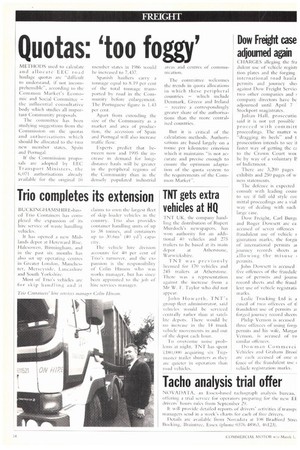Quotas: 'too fo
Page 14

If you've noticed an error in this article please click here to report it so we can fix it.
METHODS used to calculate and allocate EEC road haulage quotas are "difficult to understand, if not incomprehensible", according to the Common Market's Econoin and Social Committee the influential consultative body which studies all important Community proposals.
The committee has been studying suggestions from the Commission on the quotas and authorisations which should be allocated to the two new nic..mber states, Spain and Portugal.
If the Commission proposals are adopted by EEC Transport Ministers, the 6,071 authorisations already available for the original I() member states in 1986 would be increased to 7,437.
Spanish hauliers carry a tonnage equal to 8.19 per cent of the total tonnage trimsported by road in the Community before enlargement. The Portuguese figure is 1.43 per cent.
Apart from extending the size of the Community as a market and area of production, the accession of Spain and Portugal will also increase traffic flow.
Experts predict that between now and 1995 the increase in demand for longdistance hauls will be greater in the peripheral regions of the Community than in the densely populated industrial areas and centres of communication.
The committee welcomes the trends in quota allocations in which these peripheral countries which include Denmark, Greece and Ireland receive a correspondingly greater share of the authorisations than the more centralised countries.
But it is critical of the calculation methods. Authorisations are based largely on a tonne per kilometre criterion which it maintains -is not accurate and precise enough to ensure the optimum adaptation of the quota system to the requirements of the Common Market-.




























































